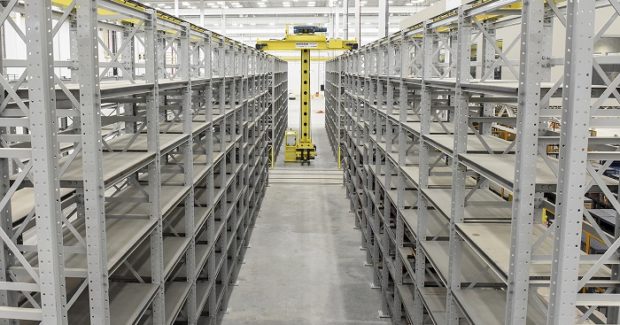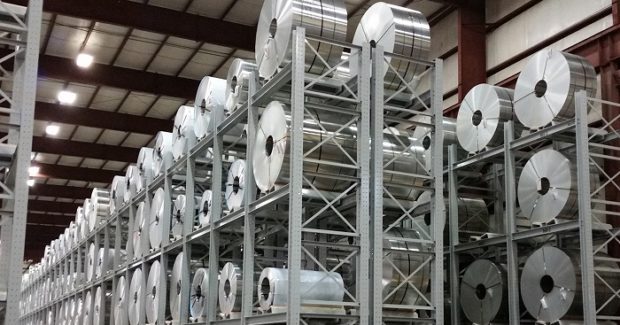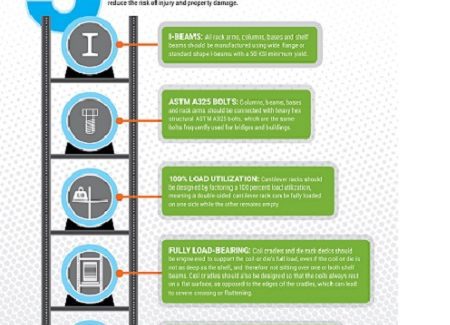Keeping the “Continuous” in Continuous Improvement
It’s still not uncommon to walk into a facility and find heavy gauge and plate materials, large stacks of coils, or bundled pipe and tubing stored on the shop floor, waiting to be retrieved and moved to another location in the plant for processing – along with all of the potential safety issues and adverse effects on profitability. Before investing in any system to solve this problem, a shop must determine exactly what they are trying to accomplish and explore how they process their inventory, right down to the orientation of the raw material when it’s initially received.
Posted: January 22, 2018
In the world of metal fabrication, it’s still not uncommon to walk into a facility and find heavy gauge and plate materials, large stacks of coils, or bundled pipe and tubing stored on the shop floor, waiting to be retrieved and moved to another location in the plant for processing. Aside from potential safety issues, this long-held storage practice adversely affects the profitability of many press rooms, steel mills, OEMs, toll processors, metal service centers and other shops due to issues with material damage, machine downtime and inefficient use of labor and space. Reducing these losses and increasing productivity often begins with the simple question: How does your current storage system impact manufacturing efficiency? This is a fundamental question that sometimes gets overlooked. Before investing in any industrial racking system, a shop must determine exactly what they are trying to accomplish and explore how they process their inventory, right down to the orientation of the raw material when it’s initially received.
The best storage system is found in the answers to these questions, especially when a shop realizes how their heavy materials can easily be stored vertically and transported with a stacker crane system or narrow-aisle side-loader. This is why many shops don’t choose the proper floor storage option for their process needs: they simply aren’t aware that a significantly safer, more efficient system is available for their application in the first place. In the metal stamping industry, a study by TechNavio (Toronto, ON) predicts the market will top $149 billion by 2021, growing at a compound annual growth rate of nearly 5 percent through the forecast period.1 This strong level of growth intensifies operational pressure and exposes inefficiencies. For example, a shop’s ability to meet order commitments can quickly become jeopardized if production equipment sits idle while employees are scouring the facility for the correct raw materials.
As demand increases and production capacities are stretched, more and more fabricators are placing a priority on keeping the ‘continuous’ in continuous improvement: they are looking for ways to minimize machine down time, streamline the flow of materials and optimize their just-in-time practices to meet production schedules and remain competitive. Part of this mission includes safely getting the right material to the right place at the right time, a goal that starts with knowing exactly where and how those products are going to be stored, even before they reach the plant. Shops that want to thrive are rethinking their manufacturing processes all the way back to material handling. Older infrastructure is also getting a second look and being more closely evaluated in light of newer storage systems that are available on the market and offer improved throughput and safety.
Buying more land and building plants is expensive. This makes maximizing existing floor space and creating an efficient facility as important as ever in affecting the bottom line. Metal fabricators should be aware that there are vertical storage and material handling systems capable of helping them achieve these objectives for their heavy duty applications. To increase their competitive position, American steel mills, OEMs, toll processors, press rooms, metal service centers and other shops can benefit greatly by investing in new storage systems that are designed to efficiently accommodate coils, sheets, tubing, pipe, bar stock, tooling, dies and molds. Because rack manufacturers design their systems using various engineering methods and materials, buyers should understand how these differences affect durability, loading capacity, and safety. Material handling is another key consideration, given that standard bridge cranes have limitations when it comes to interfacing with racks designed for certain material configurations, such as coils and dies.
The racking system should be designed specifically for heavy duty industrial storage applications and manufactured with wide flange beams that offer significantly higher load capacities and improved durability compared to roll formed steel. To ensure safety, all racks should be engineered using American Institute of Steel Construction (AISC; Chicago, IL) standards that are developed to guide the design of large steel structures, such as bridges and buildings. These sorts of industrial storage systems include coil racks, tool and die racks, and cantilever rack systems that can handle loads exceeding 80,000 lb per shelf and 20,000 lb per individual cantilevered arm. Coil and die racks can be engineered to include an integrated stacker crane that is mounted on top of the racking to provide a turnkey system. Narrow aisle side-loaders can also be used successfully for vertically storing and retrieving large coils, dies and stacks of sheet metal.
The proper racking system offers manufacturers and distributors a number of tangible benefits to build on their efforts for continuous improvements, including:
- Reduced machine downtime and improved machine uptime, because machine tools aren’t waiting for materials to be located. A modular, heavy-duty rack system gives each coil, tool or die an easily identifiable location for quick retrieval so that machine operators aren’t waiting for raw materials to be located. Transport speed can be enhanced with an automated crane system that includes inventory control software and automated data collection techniques for creating electronic pick lists and tracking material movements.
- Improved material flow for the facility. Strategic placement of racks near manufacturing equipment can improve the flow of materials through the plant.
- Greater use of vertical storage space. Utilizing vertical storage frees up shop floor space to increase production capacity and revenue potential.
- Eliminate wasted time. Marked locations allow employees to quickly store and retrieve inventory.
- Enhanced safety for workers. Storing inventory on engineered racks reduces the risk of materials moving or falling onto employees.
- Reduced chance of damage to delicate, coated, or dent-prone materials. Properly designed shelves eliminate damage caused from stacking product on top of product, stresses caused by inadequate support (such as the creasing of coils) and accidents involving forklifts and other plant equipment.
The right racking system, custom-made for the end user, can make all the difference. When the exact shop process is examined and taken into account so that a system is designed specifically around that process, the results are a more organized, efficient and safer for day-to-day operations. For shops that want to stand out in the marketplace, enhance revenues and reduce accidents, the first step is to conduct a thorough safety inspection: they should assess current storage techniques, explore what is being stored where, and talk to facility supervisors about how much time they spend walking around, looking for equipment and materials. Only then will any shop know where they truly stand in regard to safe and efficient material handling and storage.
References
- “Global Metal Stamping Market 2017-2021,” TechNavio, April 2017. Retrieved from www.technavio.com/report/global-metal-stamping-market-2017-2021.




















